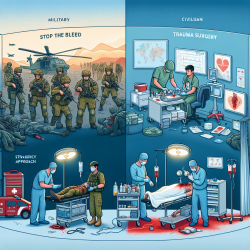Introduction
As professionals dedicated to enhancing the lives of children, it is imperative to explore and integrate effective treatment models that have demonstrated success in diverse settings. The study titled "Therapeutic community drug treatment success in Peru: a follow-up outcome study" offers valuable insights into the therapeutic community (TC) model, which can be adapted to improve outcomes in speech-language pathology and other therapeutic disciplines.
Understanding the Therapeutic Community Model
The therapeutic community model emphasizes a communal approach to treatment, where both staff and residents are equally responsible for the therapeutic process. This model fosters an environment where individuals can learn from one another through shared experiences and feedback, promoting personal growth and behavioral change.
Key principles of the TC model include:
- View of the Disorder: Addiction is seen as an individual-centered issue, with physiological symptoms being secondary.
- View of the Person: Treatment plans are tailored to individual needs, addressing common traits such as low self-esteem and poor impulse control.
- View of Recovery: Recovery is experiential, involving interaction with peers and feedback from encounter groups.
- View of Right Living: Residents are encouraged to adopt pro-social values and ethical beliefs.
Key Findings from the Peru Study
The study conducted in Peru assessed the impact of the TC model across 33 treatment facilities with 509 former clients. The findings revealed significant reductions in the 30-day use of illegal drugs and alcohol six months post-treatment. Medium to large positive treatment effects were noted, highlighting the efficacy of the TC model in fostering behavioral change.
Critical predictors of treatment success included:
- Implementation Fidelity: Higher fidelity in implementing TC principles was linked to better outcomes.
- Perceived Stigma: Lower perceived stigma post-treatment was associated with greater success.
- Client Age: Older clients showed more favorable outcomes.
Implications for Practitioners
For practitioners in speech-language pathology and related fields, integrating aspects of the TC model can enhance therapeutic outcomes. Consider the following strategies:
- Foster a Collaborative Environment: Encourage peer interaction and support among clients to facilitate learning and growth.
- Focus on Implementation Fidelity: Ensure that therapeutic interventions are delivered with high fidelity to maximize effectiveness.
- Address Stigma: Develop strategies to reduce perceived stigma and promote acceptance within the community.
Encouraging Further Research
The success of the TC model in Peru underscores the importance of data-driven approaches in therapeutic settings. Practitioners are encouraged to conduct further research to explore the applicability of the TC model in different contexts and with various populations.
Conclusion
The therapeutic community model offers a promising framework for achieving positive outcomes in treatment settings. By embracing its principles and focusing on implementation fidelity, practitioners can enhance the quality of life for their clients. To delve deeper into the original research, please follow this link: Therapeutic community drug treatment success in Peru: a follow-up outcome study.










